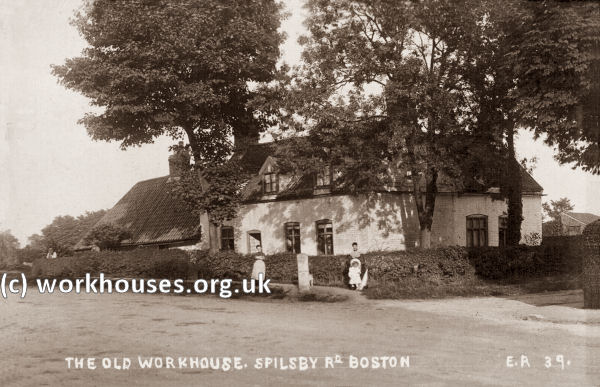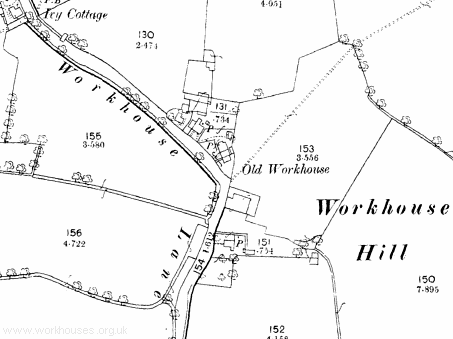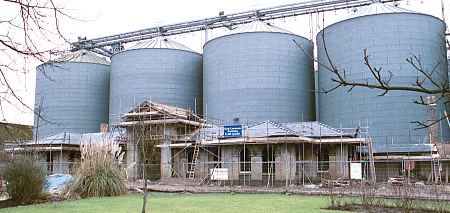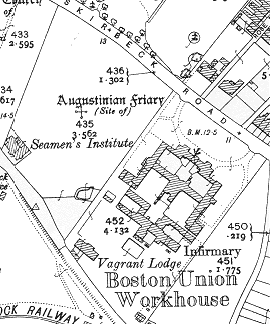Boston, Lincolnshire
Up to 1834
A parliamentary report of 1777 recorded parish workhouses in operation in Boston (for up to 26 inmates), Butterwick (10), Freiston (16), Kirton (15), Leak (35), Leverton (16), Sibsey (20), Skirbeck (12), and Swineshead (30). Boston's workhouse stood next to the gaol on St John's Row.
Boston had a workhouse from around 1726 (Hitchcock, 1985). For at least some of its history, it stood at northe side of the junction of Spilsby Road and Workhouse Lane (now Tollfield Road).

Boston former parish workhouse, early 1900s.
© Peter Higginbotham.
The Swineshead workhouse ws located on Tarry Hill, now a private residence known as Heart's Cottage. Eden, in 1797, reported on poor-relief in the parish:
Swineshead contains by estimation 4,400 acres, and 1,550 inhabitants. 166 houses pay tax, number exempt not ascertained. Prices of provisions are: Beef, 5d. per lb. ; mutton, 5d. to 5½d. ; pork, 5d. ; bacon, 9d. ; butter, 7d. or 7½d. ; potatoes, 4d. a peck; wheat, £3 10s. a quarter; barley, 36s. ; malt, 52s. ; flour, 2s. 4d. to 2s. 10d. the stone; milk, ½d. per pint, but little is sold, as farmers mostly stock their pastures with sheep. The Poor use much tea and water pottage made of water oatmeal, onions, salt and pepper, with butter when it can be got. Labourers' wages in winter are from 1s. 2d. to 1s. 6d. a day; in summer 2s. a day without victuals. In harvest 3s. to 4s. a day, and. sometimes much more. Women get 1s. to 1s. 2d. a day for weeding corn, but in winter are unemployed except in spinning jersey or worsted, at which they earn so little that scarcely one person in ten will apply for it. It is generally remarked that in these fens the people are sluggish and averse to industry. 10 ale-houses, 3 of which sell wine; no friendly society. Rent of land, about 20s. an acre. Farms from £10 to £200 a year, mostly from £40 to £100. When the fens were divided, about 27 years ago, land was given in lieu of tithes. The Poor have been farmed for more than 20 years, but there are only 5 persons in the house — a deaf and dumb shoemaker of 46, an old woman, and 3 bastard children. 13 regular out-pensioners. A few others receive casual relief, but at this season (June, 1795) the Poor are most easily maintained from the work they procure in the fields. The farmer of the Poor has £130 a year for the support of the Poor. The parish provides clothes, pays doctors' bills, etc., and relieves casual Poor who do not belong to the parish, as it is thought the farmer had too hard a bargain for some years past. Last year (1794) he had £120. A subscription made last winter for the necessitous amounted to £50. Upon the whole the Poor are well supported. Several donations, amounting to about £60 a year, are distributed among poor housekeepers. There is a charity school for 25 poor children. Certificates are granted and received without scruple. About 3 removals in a year, an appeal scarcely once in 7 years.
A workhouse stood on the east side of what is still called Workhouse Lane at Algakirk. The much altered building is now in private residntial use.

Former Algakirk parish workhouse site, 1888.
After 1834
Boston Poor Law Union was formed on 22nd September 1836. Its operation was overseen by an elected Board of Guardians, 38 in number, representing its 27 constituent parishes as listed below (figures in brackets indicate numbers of Guardians if more than one):
County of Lincoln: Algakirk, Bennington, Bicker, Boston (5), Brothertoft, Butterwick, Carrington, Dog Dyke, Fishtoft, Fosdyke, Frampton, Freiston (2), Frith Ville, Kirton (2), Langrick Ville, Leake (2), Leverton, Sibsey (2), Skirbeck, Skirbeck Quarter, Sutterton (2), Swineshead (2), Thornton-le-Fen, West Ville, Wigtoft, Wrangle (2), Wyberton.
The population falling within the Union at the 1831 census had been 29,898 — ranging from West Ville (population 118) to Boston itself (11,240). The average annual poor-rate expenditure for the period 1834-36 had been £16,695 or 11s.2d. per head.
In October 1836, the new Boston Board of Guardians advertised for plans for a new workhouse for 300 inmates and costing no more than £5,000. On 15th November, the plans submitted by George Gilbert Scott were accepted, subject to approval from the Poor Law Commissioners. The new workhouse, with it capacity raised to 350, was built in 1837 at the south side of Skirbeck Road immediately to the north of Boston Dock. The final cost was in the region of £8,000.
The workhouse design was typical of Scott's work. At the front, facing onto the road, was a single-storey entrance range with an archway at its centre, the Guardians' board-room at one side, and a chapel at the other. Probationary wards were attached at the rear.

Boston entrance block from the north-west, 2001.
© Peter Higginbotham.
Behind this was the main accommodation block, with a four-storey central portion occupied by the master and matron, with three-storey wings to the east (for males) and west (for females). To the rear stood the infirmary with the laundry and workshops at its sides. A 'vagrant lodge' was added to the south of the infirmary, although it may have originally been built as a fever hospital.
The workhouse location and layout can be seen on the 1903 map below.

Boston workhouse site, 1903.
After 1930, the site later became a Public Assistance Institution known as St John's Buildings and the infirmary block as St John's Home.
All that now remains of the workhouse is the entrance block, which stands in the shadow of giant storage silos. After lying derelict for many years, the building has been renovated by the Heritage Trust of Lincolnshire and is now used by Lincolnshire Social Services.
Cottage Home
By the 1920s, the Boston Union had established a cottage home for 13 pauper children at Brothertoft Road, Boston.
Staff
- 1881 Census
- 1901 Census. Workhouse Governor: Thomas William Steel; Workhouse Matron: Mary Martha Steel.
Inmates
Records
Note: many repositories impose a closure period of up to 100 years for records identifying individuals. Before travelling a long distance, always check that the records you want to consult will be available.
- Lincolnshire Archives, St. Rumbold Street, Lincoln LN2 5AB. Extensive holdings include Guardians' minute books (1836-38, 1841-1930); Admissions and discharges (1838-9, 1876-1930); Births (1866-79, 1914-42); Deaths (1866-1941); Offences and punishments register (1880-1941); Schools admissions/discharges (boys 1868-1902, girls 1850-1901); Certification book for pauper lunatics (1890-1928); etc.
Bibliography
- Hitchcock, T.V. (1985) The English workhouse: a study in institutional poor relief in selected counties. l695-l750. (DPhil thesis. University of Oxford.)
Links
Unless otherwise indicated, this page () is copyright Peter Higginbotham. Contents may not be reproduced without permission.


